Philippine Duck

Scientific Name
Anas luzonica
Alternative Names
Papan, Patong Gubat (Forest Duck)
Measurements
| Feature | Male | Female |
|---|---|---|
| Length | 61–66 cm (24–26 in) | Slightly smaller |
| Weight | Around 1 kg (2.2 lb) | Slightly less |
| Wingspan | About 90 cm (35 in) | About 90 cm (35 in) |
Status
The Philippine Duck is Vulnerable, found only in the Philippines. Once common, its population has fallen due to hunting and the loss of wetlands.
Identification
A large and striking dabbling duck with a bluish-grey bill that gives it a calm, graceful look. Its crown, nape, and eye stripe are black, contrasting beautifully with a warm cinnamon head and neck. The rest of its body is greyish brown, and the wings flash a bright green speculum in flight. Males and females look almost the same, though females are a bit smaller.
Voice
Usually quiet, though it may make soft quacks or whistles when disturbed or during social calls.
Diet
Feeds on a variety of foods such as plants, rice, crustaceans, insects, and small fish — often seen foraging in shallow water or flooded fields.
Distribution
Endemic to the Philippines, mainly found on Luzon and Mindanao, with rare sightings in Taiwan and Japan.
Habitat
Prefers shallow freshwater wetlands, lakes, and rice paddies but also visits rivers and coastal areas.
Breeding
Believed to nest from March to November, peaking in mid-year. Nests are well hidden in vegetation, with the female laying around 10 eggs and incubating them for about 25–27 days.
Wintering
Non-migratory — it stays in the Philippines year-round, moving locally depending on food and water levels.
Conservation
Protected in several national parks and wetlands, though enforcement against hunting remains weak. Conservation efforts focus on wetland protection and habitat restoration to help the population recover.
